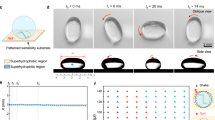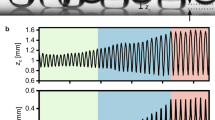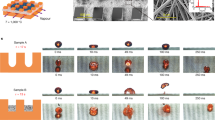Abstract
WE report here the observation of hot metal particles which remain suspended above a cool liquid surface by vapour generation: the effect may be referred to as the inverse Leidenfrost phenomenon, by analogy with the well known effect of the suspension of a liquid drop above a heated surface1. The mechanism of suspension in the latter case is postulated to be the pressure produced by vapour escaping from beneath the drop, the vapour having been generated by the action of the hot surface on the drop2.
This is a preview of subscription content, access via your institution
Access options
Subscribe to this journal
Receive 51 print issues and online access
$199.00 per year
only $3.90 per issue
Buy this article
- Purchase on SpringerLink
- Instant access to full article PDF
Prices may be subject to local taxes which are calculated during checkout
Similar content being viewed by others
References
Leidenfrost, J. G., see Int. J. Heat Mass Transfer, 9, 1153 (1966).
Gottfried, R. S., and Bell, K. J., I. and E.C. Fundamentals, 5, 561 (1966).
Author information
Authors and Affiliations
Rights and permissions
About this article
Cite this article
HALL, R., BOARD, S., CLARE, A. et al. Inverse Leidenfrost Phenomenon. Nature 224, 266–267 (1969). https://doi.org/10.1038/224266a0
Received:
Issue date:
DOI: https://doi.org/10.1038/224266a0
This article is cited by
-
Computational study of laser fragmentation in liquid: Phase explosion, inverse Leidenfrost effect at the nanoscale, and evaporation in a nanobubble
Science China Physics, Mechanics & Astronomy (2022)
-
Hyperpolarization via dissolution dynamic nuclear polarization: new technological and methodological advances
Magnetic Resonance Materials in Physics, Biology and Medicine (2021)
-
In-flight Behavior and Deposition Mechanism of Copper Coating on Polyacetal Resin Substrate
Journal of Thermal Spray Technology (2020)
-
Self-propulsion of Leidenfrost Drops between Non-Parallel Structures
Scientific Reports (2017)



